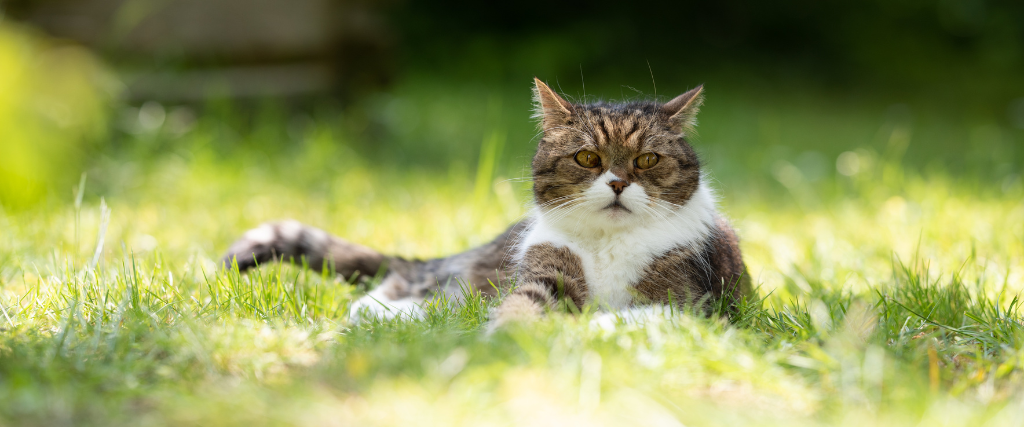Cats who spend time outside may experience a variety of difficulties when suddenly brought indoors. The limited space can lead to frustration and boredom, which can cause destructive or aggressive behavior. Additionally, outdoor cats may become anxious and stressed due to a lack of normal stimuli. They are used to the smells, sounds, and sights of the outdoors, and without those things, cats can feel like their new environment is pretty boring.
A slow transition is the best way to prevent these issues from arising when bringing an outdoor cat inside. With patience and care, your outdoor cat can adjust to being indoors just as easily as cats who were born inside.
Whether you've recently decided that you want your outdoor cat to be an indoor-only cat or you're planning to welcome a stray into your home, there are a few things you'll need to do to make a successful transition. Here are a few tips from your veterinarian on how to make the switch with minimal stress for you and your feline friend.
Provide a Small Room with All of the Essentials
Minimizing stress is crucial when bringing an outdoor cat inside. To do that, start off by providing them with a small and comfortable room of their own. This room should be quiet and inaccessible to children and other pets. If possible, choose a room that is away from the busiest areas of your home, too. For safety, make sure the room doesn't have any openings a cat could squeeze through to get back outside.
Equip the room with all the essentials needed for a happy cat.
Essential items for cats include:
- A litter box
- Comfortable bedding
- Food and water bowls filled with fresh food and water
- Toys to keep them entertained
You may also want to add a few items your cat can hide inside or under. Cardboard boxes work well. Draping a sheet over a small table is a good option, too, since it creates a cozy nook for your cat to hide out in. Providing a comfortable environment with all of the essentials helps them feel safe and secure in their new environment while they adapt to life indoors.
Also, keep your new friend in their own room until you've had a chance to bring them in for a checkup—especially if you have other pets. Even if your other animals are vaccinated, an outdoor cat could expose them to diseases and parasites, so it's important to seek prompt veterinary care when bringing one indoors. Be sure to collect a stool sample and bring it along to the appointment for fecal analysis.
Let Them Adjust at Their Own Pace
Providing outdoor cats with their own space to adjust to a new environment is incredibly important. Let them explore and come out at their own pace, and don't force them to socialize or spend time around other people or pets until they're ready. Spend ample amounts of time reassuring your new indoor cat, but give them space, too. This is a crucial step in ensuring that your new indoor friend feels relaxed and content.
You can slowly introduce your former outdoor cat to people and other pets, but don't rush anything. Let them adjust at their own pace and chances are that, in due time, you'll have a happy former outside cat who loves their new indoor home.
Provide Vertical Space
When outdoor cats move inside, it’s important to provide them with the vertical space they need. This allows them to remain true to their natural instincts even when they no longer have access to trees and other things to climb outside.
Indoor climbable items, like cat trees and shelves, help cats establish a comfortable and secure environment in their new home. Cats will take advantage of these higher-up resting spots, which provide them with some great viewpoints around the house and help them stay out of harm’s way, especially when they feel nervous in their new home. Providing cats with vertical space is also beneficial for exercise since cats will easily jump up to climb their cat tree or perch on a shelf. In this way, vertical space helps them remain healthy and active.
Provide Enrichment Activities to Engage Their Bodies and Brains
Ensuring that indoor cats have the opportunity to use their natural hunting and playing instincts helps them stay healthy and happy. Doing so also helps them maintain a healthy weight and provides an outlet for stress and anxiety.
There are a lot of enrichment activities you can provide for your cat to stimulate their body and mind. Puzzle feeders give cats the satisfaction of "hunting" for their food by forcing them to use their cognitive skills to figure out how to get a reward. Scratching posts allow cats to mark their territory as if they were outside. In addition to keeping them entertained, scratching posts help keep their claws healthy—and your furniture scratch free. Toy balls filled with treats provide your kitty with an amusing challenge as they bat and swat at the toy until it finally gives up its delicious prize. There are so many different ways you can satisfy your furry friend's natural instincts indoors.
Closing Thoughts
Bringing an outdoor cat into your home is a big adjustment for both you and your new pet. By following the steps above, you can make the transition as smooth as possible for everyone involved. Be patient with them as they adjust, and give them the time and space they need to feel comfortable in their new home. Remember to provide plenty of enrichment activities to keep them stimulated and happy. If you have any questions or concerns, don't hesitate to contact us. We're here to help you and your new cat every step of the way.

